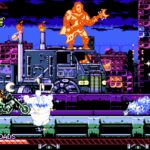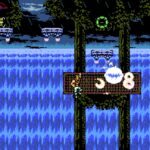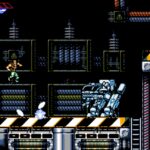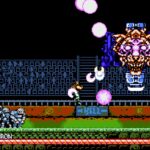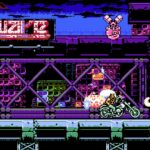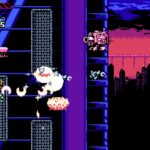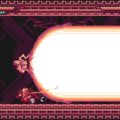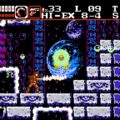Developer: Programancer Publisher: Retroware Release: 08/29/23 Genre: Action Also on: Switch, PS4, PS5, Xbox One, Xbox Series
I love retro games. That should be obvious; you are on my retro video game website after all. However the indie game industry continues to create games patterned after many of the classics I enjoyed growing up. You could say I am happier than a pig swimming in its own you know what, so to speak. While there are legions of games that draw inspiration from Mega Man, Zelda, and especially Metroid you will not find many that reference say Power Blade, a forgotten Taito gem. Prison City is that game and is much more, it is a fantastic game in its own right.
Prison City takes place in an alternate universe version of Detroit that was abandoned in 1994. The city has become a penal colony where they house the worst criminals in the country behind a massive wall. Three years later Detroit techno terrorists invade and plan to use the prisoners as a massive army to overrun the country. The police chief enlists former cop Hal Bruzer to take out the eight wardens running the show and hopefully restore order to the city.
The game has an optional tutorial and with good reason. Mechanically Prison City is dense. Gameplay wise Prison City is a combination of Power Blade and the platforming of Shatterhand. Hal has a chakram that can be thrown in every direction, held in place, rotate manually and can pick up items. You can throw multiple chakrams and to prevent spamming there is a weapon meter that governs the strength of attacks. To be completely honest I did not notice a massive difference between spamming attacks and balancing strikes. Hal can grab and climb fences and ledges, skills that the game calls on heavily. There are also other techniques like slide jumping but these are optional.
After the intro level Prison City begins with a Mega Man style level select. Unlike Capcom’s classic series you do not gain enemy weapons that make subsequent levels easier. In fact there are few power-ups overall. For the adventurous every level features an upgrade to your life bar or weapon meter. But to find each requires deft exploration. The order you tackle the levels determines the difficulty of your journey. Some levels like the Sewer and Preserve are clearly meant to be first as they are short and linear. Others like the Power Plant are complex and feature some of the most difficult platforming in the game. Aside from Hal’s choice of weapon the Power Blade connection comes in the need to find an agent who gives the key card necessary to access the level warden. Thankfully there is no time limit so it is not laborious as that game.
Mechanically Prison City is sound. But it is in its level design that the game truly shines. Prison City is a game that takes its cues from the past but is keen on avoiding their mistakes. They manage to strike an odd balance; the levels are large enough to feature multiple paths to its one exit yet still focused as there are no dead ends. The handy minimap also means it is impossible to get lost. The levels and their themes are varied and present unique challenges. Cold Storage features brittle ice platforms that break under your weight as well as ice trucks that spell instant death. The Stadium is platform heavy and a fun diversion with its circular design. For a change of pace the Freeway begins with an auto-scrolling bike sequence before the platforming begins. That variety is the game’s greatest strength.
The boss battles are hit or miss. Sometimes they swing for the fences and nail it. The plant creature in the Preserve has a simple yet challenging pattern that requires patience. Cold Storage is one of the harder stages and almost as a reprieve you play a game of pong. The giant spider mech at the end of the factory reminds me of Metal Gear. You can slowly wear it down or use its weapons against it to speed up the fight, more than likely the intended purpose. If I have one complaint regardless of how much I enjoy an encounter it is that their life bars are way too long.
I can appreciate when devs try to be creative. But when Prison City fails it fails hard. The end of the Freeway is straight out of Mad Max as a rig full of road warriors chases you down. Unfortunately the short reach of your chakram makes it frustrating and easy to take damage trying to get your licks in. The Power Plant is one of the best levels in the game but its boring battle against a series of robotic cubes is a disappointment. Some are so simple it is like they gave up trying. I will say the finale and ensuing battles in the Wily toweresque DCP HQ make up for it.
Although Prison City resembles a more advanced NES game it is Nintendo hard. The game is generous with its extra lives as you begin every level with five and can easily find more. Most enemies drop health power-ups regularly and mid-level save points are common. Before every hard section there is usually always an extra life nearby to alleviate repeat attempts. Despite these amenities the game still puts up a fight with varying platforming challenges depending on the level. Outside a few boss battles I have few complaints. The final few levels are a culmination of every platforming trick in the game and a worthy test of your skills. It is very Mega Man in that regard. I beat the game on normal so I can only imagine the easy setting is more accommodating.
In Closing
Prison City is the 16-bit Power Blade that never was and is a fantastic retro throwback. Although it features nostalgic callbacks to games of yore it does not lean on them to thrill the player. Indeed the game avoids the mistakes they make in regards to difficulty and balance and is accessible yet challenging when it needs to be. This is the best $10 I have spent in a long time and I cannot recommend this game enough.


